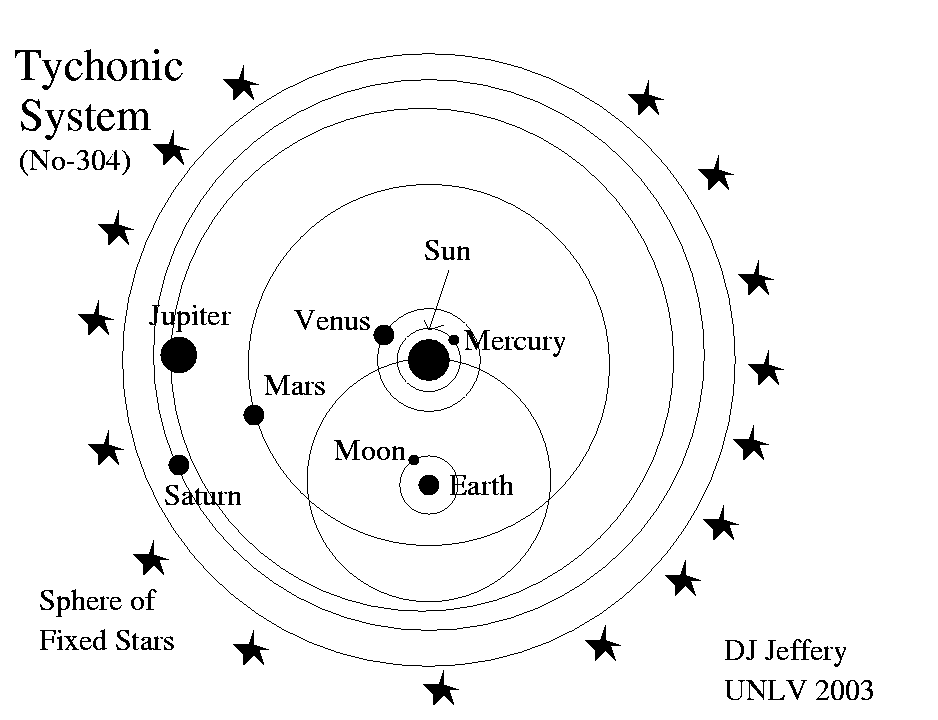
Caption: A cartoon of the Tychonic system of Tycho Brahe (1546--1601).
Features:
- Tycho
presented the Tychonic system
in
De Mundi Aetherei Recentioribus Phaenomenis Liber Secundus (The Second Book About Recent Phenomena in the Celestial World)
(1588).
(see Famous Scientists: Tycho Brahe).
- The Tychonic system
is Copernican system turned on its head
so to speak.
All the planets orbit
the Sun (except the
Earth which is NOT a
planet in the
Tychonic system)
and the Sun
and Moon orbit
the Earth.
The Earth is unrotating (unlike in the Copernican system) and celestial sphere of the stars still rotates daily around the Earth on the celestial axis just as in Aristotelian cosmology and the Ptolemaic system.
So the Earth alone is fundamentally at rest in the Tychonic system---and, to repeat, is NOT a planet---which means the planets are NOT like the Earth and you do NOT have to worry about them having extraterrestrial life.
- NEITHER Tycho
NOR anyone else as far as yours truly knows
ever developed a mathematically predictive version of the
Tychonic system with
epicycles and other
ancient devices.
So there are probably NO
Tychonic system
ephemerides.
The people who adopted the Tychonic system circa 1600 and later as physically real were probably content to just use as calculating tools the Ptolemaic system, Copernican system, or, once it had come along, Johannes Kepler's (1571--1630) heliocentric system as expressed in Rudolphine Tables (1627).
Such people would have been following a longstanding tradition of regarding the physical reality of the Heavens as distinct from the mathematical astronomy used to create ephemerides. The tradition was established by the dual adoption for millennia of Aristotelian cosmology as physically real and the Ptolemaic system as a calculating tool.
From the perspective of modern science, this is a silly tradition. If you CANNOT make verifiable predictions from a theory, it is inadequate and may well be plain wrong---like Aristotelian cosmology.
- The Tychonic system has all the
advantages in determining
Solar System distances and geometry
that the Copernican system has
(see
Procedure for Orbital Radius Determination for Inferior Planets
and
General Procedure for Orbital Radius
Determination).
In particular, apparent retrograde motion has the same the simple explanation as in the Copernican system.
But unlike the Copernican system, the Earth does NOT move (which was deemed essential by Tycho and many of his contemporaries), is NOT a planet (which people then found hard to believe), and stays the center of the universe. Furthermore, the Tychonic system did NOT require a huge celestial sphere of the stars to explain the lack of observed stellar parallax since the celestial sphere of the stars stayed centered on the Earth. But, of course, the celestial sphere of the stars still had to have diurnal rotation just like in the Aristotelian cosmology: it had to whip around the Earth's axis once per sidereal day = 86164.0905 s = 1 day - 4 m + 4.0905 s (on average) with all other celestial motions being superimposed on that diurnal rotation.
- To many contemporaries of
Tycho
and 17th century persons,
the Tychonic system
seemed the happy compromise between "old/rational/physical"
Aristotelian cosmology
and the "new/absurd/geometrical"
Copernican system.
Especially important to them, the Earth was still the center of the universe, and so humankind was still really, really important.
However, the Tychonic system did get rid of the celestial spheres (except for the celestial sphere of the stars) of Aristotelian cosmology which Tycho proved did NOT exist at least in any solid-body sense. In fact, there was NO reason to believe in those celestial spheres anymore---actually there NEVER had been much reason to.
To conclude, the Tychonic system was a new improved cosmos that was NOT too radical.
- The ideas for Tychonic system
were NOT entirely original to Tycho
and he may NOT have acknowledged this adequately
(see Wikipedia: Tychonic system;
Wikipedia: Tychonic system:
Precursors to Geo-heliocentrism;
Wikipedia:
Tychonic system: History and development of the Tychonic system).
However, Tycho gave a forceful presentation of the Tychonic system and that counts for a lot in assigning credit in science.
Many people can mention speculative ideas some of which may turn out to be right or at least plausible to some (as is the case with the Tychonic system). Presenting those ideas with arguments/proofs takes more work and generally gets more credit in science.
In any case, the importance of an achievement is much the same whoever gets the credit. For example, did you know that the Iliad and the Odyssey were NOT written by Homer (circa 700 BCE), but by another ancient Greek of the same name. Fact.
- From a purely rational point of view,
Johannes Kepler's (1571--1630)
heliocentric solar system---the
Keplerian system---made
the Tychonic system very implausible.
In the Keplerian system, the Earth obeys Kepler's 3 laws of planetary motion just as if it were a planet.
So it is reasonable to conclude the Earth probably is a planet and NOT a fundamentally different entity. An immediate corollary to the conclusion is that the Sun defines the physical reference frame of the Solar System: the reference frame in which the motions of the planets are explicable in terms of physical laws.
This conclusion must have become clear to most astronomers sometime in the course of the 17th century even before they had the true physical laws from Isaac Newton's (1643--1727) Principia (1687).
Certainly, Galileo and Kepler believed that the true physics would be one in which the Sun defined the physical reference frame of Solar System motion. This belief was based on their weighing of the evidence available---and, of course, they were correct---as we now know.
- Actually, the
Tychonic system
is useful as an observational perspective since
the Earth is our observing platform.
So in a sense the
Tychonic system continues to be used,
but astronomers generally do NOT call
the Earth-based perspective the
Tychonic system.
Credit/Permission: ©
David Jeffery,
2003 / Own work.
Image link: Itself.
Local file: local link: tychonic_system.html.
File: Tycho file:
tychonic_system.html.